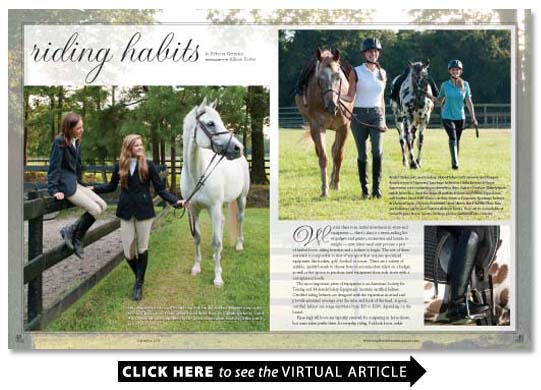Riding Habits
BY Rebecca Germain
While there is an initial investment in attire and equipment theres almost a never-ending list of gadgets and gizmos accessories and brands to sample new riders need only procure a pair of heeled boots riding breeches and a helmet to begin. The cost of these essentials is comparable to that of any sport that requires specialized equipment like hockey golf football or soccer. There are a variety of reliable quality brands to choose from to accommodate riders on a budget as well as the option to purchase used equipment from tack stores with a consignment booth.
The most important piece of equipment is an American Society for Testing and Materials/Safety Equipment Institute certified helmet. Certified riding helmets are designed with the equestrian in mind and provide extended coverage over the sides and back of the head. A good certified helmet can range anywhere from $35 to $200 depending on the brand.
Knee-high tall boots are typically reserved for competing in horse shows but some riders prefer them for everyday riding. Paddock boots ankle boots with a lace or zip closure are the more popular choice for riding in a lesson program. Many riders wear these in combination with half-chaps knee-high leather or synthetic leg coverings that protect the shins and calves provide grip and mimic the feel of tall boots without scuffing wearing or damaging expensive show attire. Tall boots vary in price from $150 to $1 000. Paddock boots can range from $40 to $150. Half-chaps are typically $40 to $100. There are many varieties of riding breeches: schooling tights and riding jeans for lessons and cotton or wool breeches for showing. A good pair of lightweight schooling breeches can cost $40 to $100.
While theres no particular etiquette pertaining to the kind of shirt riders wear for lessons and schooling generally instructors prefer riders to wear tailored or form-fitting shirts tucked into their breeches to fully assess the riders position and equitation. Many riders wear sweat-wicking athletic shirts or polos in the summertime to keep cool and thermal blend long-sleeved shirts in the winter.
There are numerous other items riders purchase to increase comfort provide protection and improve training: gloves equestrian sunglasses full-chaps barn clogs spurs and crops.
If a rider wishes to compete formal show attire must be purchased. In addition to tall boots helmet and breeches competitive riders must also invest in a show jacket $48 to $400; blouse $20 to $70; stock pin a decorative addition to the blouse collar $5 to $20; hairnet $3 to $15; gloves $5 to $40; and belt $20 to $40.
